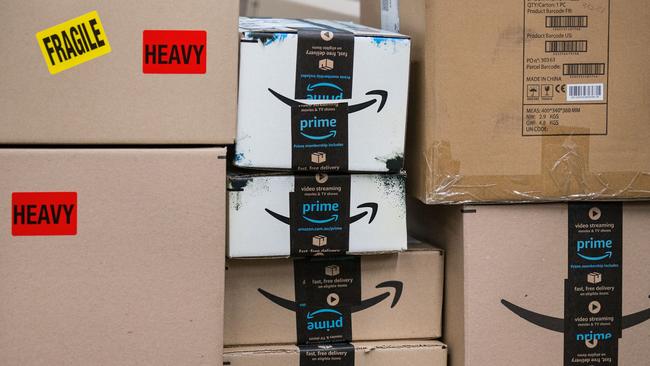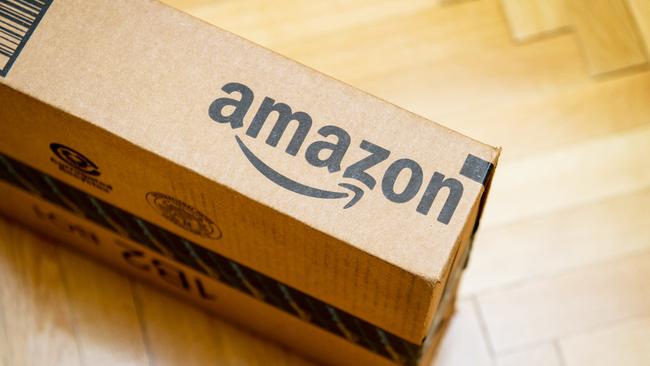Green squeeze: Amazon’s bid to fit 200 million items into just 50 box sizes
The online retail giant says the reason your single item arrived in a box three times its size was intentional, and that it can sometimes be better for the environment. Here’s why.

The world’s biggest tech companies are in a race to become greener, investing in a suite of measures to fight climate change, from making their products carbon-neutral and ramping up their use of renewable energy to altering their packaging.
Some of the initiatives may seem counterintuitive. Anyone who has bought an item from Amazon – the $US1.37 trillion ($2.16 trillion) e-commerce titan – might be perplexed at the size of boxes it uses.
For example, a single bottle of hand cream might arrive in a package big enough for three or maybe four. But Amazon Asia Pacific operations director Akhil Saxena said this is designed to eliminate waste, not add to it.
“We have 200 million items available for sale at Amazon in Australia. Those 200 million items are trying to fit in about 50 boxes and packages,” Mr Saxena told The Australian on a visit to the company’s headquarters at Seattle.
“So what we typically do is every month we collect the data on what you’re shipping, in what box we’re shipping and use that to optimise the suite of the boxes that we have to pack those items in.
“You cannot have all the kinds, all the sizes of the boxes that are there, right? But you use machine learning to say what’s the most optimal size of the box.”

The boxes are also made from recycled paper, which Mr Saxena said could be recycled again.
“And then we are also looking at … the weight of the box itself. Reducing the weight also allows us to do things that are more efficient in the transportation part of it.”
Optimising its use of boxes forms part of Amazon’s goal to hit net-zero carbon emissions by 2040 – 10 years ahead of the Paris Agreement – and transitioning all of its operations to renewable energy by 2035.
It comes after Apple launched its first carbon-neutral products – the new Apple Watch line-up – last month. The company plans to make every product carbon-neutral by the end of the decade, including the entire global supply chain and the lifetime use of every device it makes.
Apple thrives on the buzz of launching new products each year, heaping more pressure on the company to be greener. After all, the most environmentally friendly choice a person can make is to keep your existing mobile phone or smartwatch an extra year or two.
But items eventually wear out or become obsolete. Mr Saxena says Amazon plans to tackle that.
“Last year, we launched a program via Amazon warehouse deals, which is to say items which have been returned back, if they can be refurbished and sold, then we reduce the amount of landfill that is required.”
Apple has also ended the use of leather across all of its product lines, launched fibre-based packaging for its new Apple Watches and expanded the use of recycled materials in iPhones.
Furthermore, it has given consumers more control over their emissions, introducing a new tool in its Home app called Grid Forecast. This is designed to inform people when the grid has more renewable energy available, prompting a change to greener habits.

“Our focus on renewable energy and low-carbon design has already driven industry-leading emissions reductions, and we’re not slowing down,” said Lisa Jackson, Apple’s vice president of environment, policy, and social initiatives.
“We’ve achieved an important milestone in making the world’s most popular watch carbon-neutral — and we will keep innovating to meet the urgency of the moment.”
Microsoft has also committed to becoming carbon negative by 2030, and plans to reverse all the greenhouse gas emissions it has produced since its founding in 1975 by 2050.
“The scientific consensus is clear. The world confronts an urgent carbon problem. The carbon in our atmosphere has created a blanket of gas that traps heat and is changing the world’s climate,” Microsoft president and vice chair Brad Smith said when the company declared its green vision three years ago.
“Already, the planet’s temperature has risen by 1 degree centigrade. If we don’t curb emissions, and temperatures continue to climb, science tells us that the results will be catastrophic.”
Locally, Telstra’s venture capital arm has been scouring the market to invest in tech start-ups aimed at tackling climate change and greenwashing – ensuring companies live up to their ambitious emission slashing goals.
Telstra Ventures – which has more than $1.3bn in funds under management – raised $500m last year to invest in green start-ups. Investments have included leading a €20m capital raising for a Swiss renewable energy trading platform Pexapark last month.
It has also backed OpenSolar, which provides software to contractors to design a solar panel installation and provide customers with accurate performance data – including estimated savings from switching to renewable energy
While Telstra Ventures has been scouting the market for green tech companies, managing director Matthew Koertge has stressed repeatedly that Telstra Ventures was not becoming a climate fund.
“Our thesis is that the rapidly rising carbon levels are frightening the living daylights out of us,” Mr Koertge said last September.
“This is just so important, and many companies are starting to recognise that urgent action is needed. There’s likely to be 1000 unicorns of companies that will potentially address that opportunity and hopefully there will be strong investment returns on the back of that as well.”
Jared Lynch travelled to Seattle as a guest of Amazon.







To join the conversation, please log in. Don't have an account? Register
Join the conversation, you are commenting as Logout